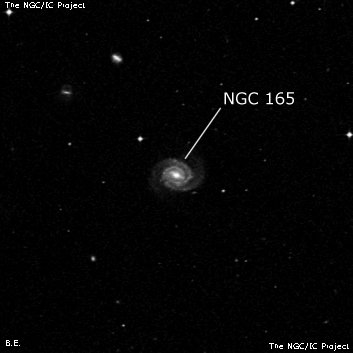
William Herschel discovered NGC 165 = H III-954 on 10 Dec 1798 (sweep 1086) and recorded "eF, S." His position is just 1.6' north-northwest of NGC 165 = PGC 2182, and much further from NGC 163 = MCG -02-02-066 = PGC 2149, the galaxy associated with III-954 in the NGC. In the 1912 "Scientific Papers of WH", Dreyer noted the RA of H. III-954 was 28 sec too large (for NGC 163). Wolfgang Steinicke and Harold Corwin agree with the conclusion that H. III-954 more likely applies to NGC 165.
Wilhelm Tempel independently found NGC 165 in 1882 with an 11" refractor at the Arcetri Observatory and reported it in his fifth discovery paper. In his note on NGC 163, he mentions he found another fainter nebula 30 sec following. Tempel's second nebula was assumed to be new, so he was credited with the discovery of NGC 165 in the NGC. Spitaler measured an accurate position in 1891 at Vienna. Based on a photograph taken with the Crossley reflector between 1912-13, Heber Curtis described NGC 165 as "Nearly round, 1' in diameter. A very faint, rather regular spiral. Nucleus almost stellar."
400/500mm - 17.5" (9/17/88): faint, fairly small, almost round, very weak concentration, low surface brightness. Slightly larger but fainter than NGC 163 6' W. A mag 14 star lies 1.5' NE.
600/800mm - 24" (8/29/19): at 375x; between fairly faint and moderately bright, fairly small, slightly elongated, brighter core, low surface brightness halo ~45" diameter. A mag 13.5 star is 1.4' NE. NGC 165 is the fainter of a pair with NGC 165 7' E. A mag 9.6 star (HD 3336) lies 7' NW.
MCG -02-02-064, located 15' NW, appeared faint, oval ~5:2 SSW-NNE, soft even surface brightness, ~0.75'x0.3'
Notes by Steve Gottlieb